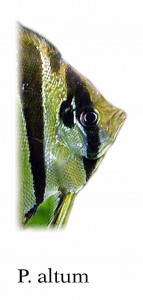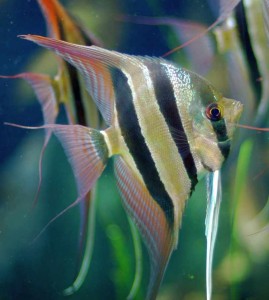The Orinoco Angelfish (Pterophyllum altum) known to tropical fish keeping enthusiasts as the Altum Angelfish, Deep Angelfish, Orinoco altum or Altum Angel is found in the Orinoco River basin and the upper Rio Negro watershed in Southern Venezuela, Southeastern Columbia, and the Northen part of Brazil.
Most Orinoco Angelfish are found in the well oxygenated, extremely soft waters of upper and middle Orinoco tributaries shed from the Guiana Shield Highlands and to a lesser degree in the Atabapo and Inirida River floodplain, and down the Casiquiare and Guainía floodplain where the Rio Negro begins.
In the wild Orinoco Angelfish live in flood plains and river watersheds with moderate water flow among the submerged trees, plant roots, and underwater vegetation, but more often in very soft, well oxygenated waters where they feed on smaller fish, invertebrates, and food particles in the water.
The Orinoco Angelfish is the largest of the three species in the Pterophyllum genus. Although they measure about 7 inches in length, they are very tall with extensive fins. The height from the tip of the dorsal fin to the tip of the anal fin, can measure as much as 16 inches in length.
 The Orinoco Angelfish is silver in color with three brownish red vertical stripes and red striations that go into the fins. When mature, they may show red spotting and a blueish green cast to the dorsal fin. When Pterophyllum altum are aroused, they develop a black operculum spot.
The Orinoco Angelfish is silver in color with three brownish red vertical stripes and red striations that go into the fins. When mature, they may show red spotting and a blueish green cast to the dorsal fin. When Pterophyllum altum are aroused, they develop a black operculum spot.
One characteristic of all true Orinoco Angelfish is the acute incision or notch above the nares (nostrils) on the upper part of their snout.
The two other species have a flat or slightly rounded forehead. Commercial hybrids with Petrophyllum scalare will not exhibit this trait, or it may be appear to a lesser degree. Although they closely resemble and are colored very similar to Pterophyllum scalare, they will always display a distinctive notch above the nares.
Orinoco Angelfish are timid and considered to be the most peaceful of all the angelfish species. When they are first introduced into the aquarium, they are easily frightened by fast movements and shadows but after they are acclimated, they become quite personable.
Although Orinoco Angelfish are considered a community fish, they may intimidate smaller fish in the tank. As juveniles, they will peacefully school but as they grow into adulthood, they pair off and usually become territorial.
Because of their size, Orinoco Angelfish need a minimum tank size of at least 55 gallons and definitely larger if keeping a breeding pair or a community tank. They do best with a sandy or fine gravel substrate that is densely planted around the perimeter of the tank and aquascaped with some rocks and driftwood roots for them to hide among. They will be most at home in a warm tank with plenty of swimming space. Strong filtration and a power head
to provide moderate water movement is necessary to mimic their native habitat.
These cichlids are very sensitive to water conditions and need soft (0-5dH), very acidic water to thrive. An excellent filtration system and frequent partial water changes of at least 25% every week is a must for these fish. Because these cichlids are also prone to stress related diseases, care should be taken when cleaning the tank and making partial water changes.
True wild caught Orinoco Angelfish are extremely difficult to breed in an aquarium environment however, a few tropical fish keeping enthusiasts have successfully bred the species making captive bred specimens, along with wild caught fish available to the trade.
In the wild, Orinoco Angelfish are open breeding egg layers that form nuclear families and prefer to spawn on submerged roots or tree branches that are located in moderate currents in waters with a temperature between 78 and 88 °F and a pH of 5.8 to 6.2. Pterophyllum scalare on the other hand prefer spawning on the leaves of submerged plants and trees in flooded rain forests.
Because they are difficult to sex, its best to start with a small school of about 4 to 8 fish and allow them to pair off. When you have a pair, they need to be conditioned to spawn. Feed them a high protein diet and provide them with warm, soft, acidic and exceptionally clean water with a pH of 5.8 – 6.2, a hardness of 1 – 5 dGH, and a temperature of 86 – 87.8° F.
When ready to spawn, the female will lay up to 1000 eggs on a submerged root or on cleaned leaves. The male will follow the female and fertilize the eggs. If the parents don’t eat the eggs, they will hatch in a few days and the fry will be free swimming within a week. The larvae and fry are carefully guarded by the pair and the fry will follow the parents in a small school as they swim around the tank. Feed the fry newly hatched brine shrimp for the first couple of weeks until they are able to eat regular food.
Orinoco Angelfish will generally eat a variety of live, frozen, freeze dried, and flake foods. Feed them a high quality flake food or pellet daily along with live or frozen brine shrimp or bloodworms
as a treat. They should be given occasional treats of mosquito larvae, but do not overfeed. Being omnivores, they should also be given regular feedings of spinach, cucumbers or lettuce.
True Altum Angelfish or Orinoco Angelfish are becoming more frequently imported and are regularly available online and in specialty fish stores and are more pricey than common Angelfish. Hybrids developed by crossing the Pterophyllum altum with Pterophyllum scalare are called “Orinoco Altum” and are occasionally available, but are usually more expensively priced.
Minimum Tank Size: 55 gallons
Care Level: Difficult
Temperament: Peaceful
Aquarium Hardiness: Moderately hardy
Water Conditions: 78.0 to 84.0° F, 2-10 dGH, pH 4.5-5.8
Max. Size: 15.8 inches
Color Form: Black, Silver, Black, Red
Diet: Omnivore
Compatibility: Peaceful community tanks
Origin: Orinoco River basin
Family: Cichlidae
Life Span: 15 years
Aquarist Experience Level: Intermediate




